人教版八年级英语上册第六单元说课教案
- 格式:docx
- 大小:12.91 KB
- 文档页数:4
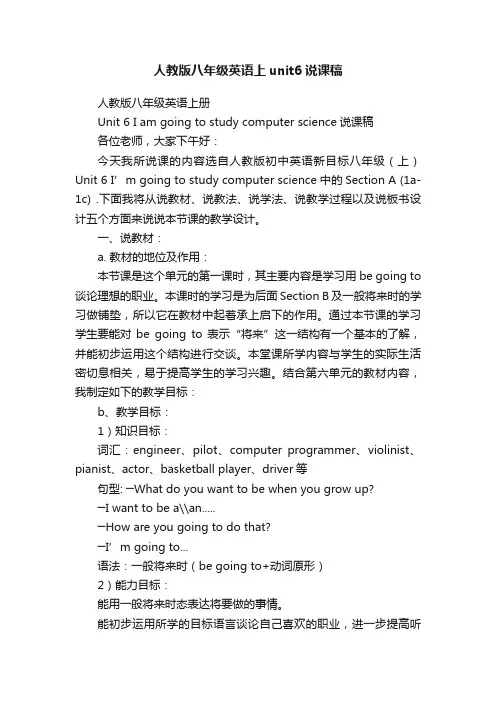
人教版八年级英语上unit6说课稿人教版八年级英语上册Unit 6 I am going to study computer science说课稿各位老师,大家下午好:今天我所说课的内容选自人教版初中英语新目标八年级(上)Unit 6 I’m going to study computer science中的Section A (1a-1c) .下面我将从说教材、说教法、说学法、说教学过程以及说板书设计五个方面来说说本节课的教学设计。
一、说教材:a. 教材的地位及作用:本节课是这个单元的第一课时,其主要内容是学习用be going to 谈论理想的职业。
本课时的学习是为后面Section B及一般将来时的学习做铺垫,所以它在教材中起着承上启下的作用。
通过本节课的学习学生要能对be going to表示“将来”这一结构有一个基本的了解,并能初步运用这个结构进行交谈。
本堂课所学内容与学生的实际生活密切息相关,易于提高学生的学习兴趣。
结合第六单元的教材内容,我制定如下的教学目标:b、教学目标:1)知识目标:词汇:engineer、pilot、computer programmer、violinist、pianist、actor、basketball player、driver等句型: ─What do you want to be when you grow up?─I want to be a\\an.....─How are you going to do that?─I’m going to...语法:一般将来时(be going to+动词原形)2)能力目标:能用一般将来时态表达将要做的事情。
能初步运用所学的目标语言谈论自己喜欢的职业,进一步提高听说读写的能力3)情感目标:本节课通过对职业的谈论和学习,让学生有一个自己的目标和计划,并对能他们的梦想有个积极的态度。
c、教学重、难点:1)重点:掌握本节课中表示职业的新词汇和句型,学生根据自己喜欢的职业,运用所学知识谈论自己打算怎样做来实现目标一般将来时中be going to的用法2) 难点:一般将来时be going to 中be 的具体形式和后面接动词原形的用法学生容易混淆.二、说教法为了顺利地完成教学目标,更好地突出重点、突破难点,我重点采用任务型教学法,听说法,将布置任务进行小组交流活动贯穿整堂课。
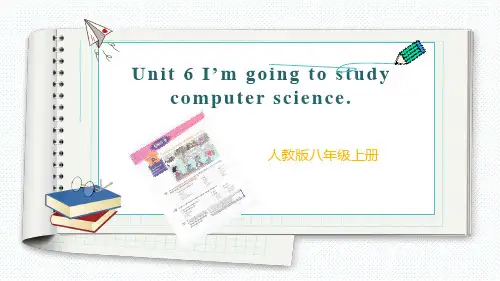
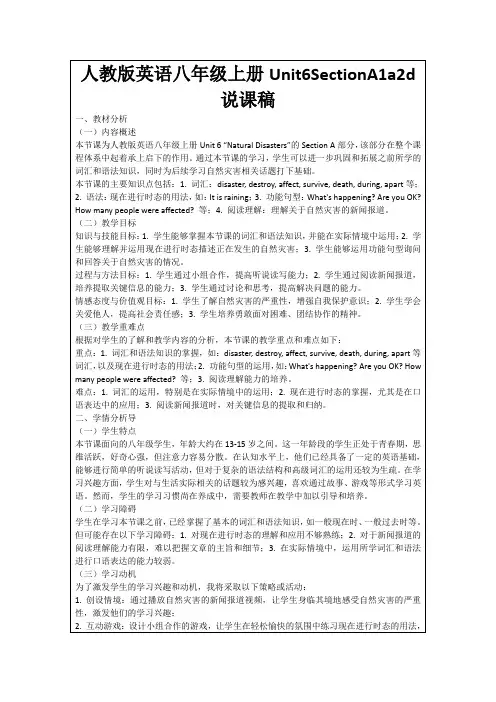
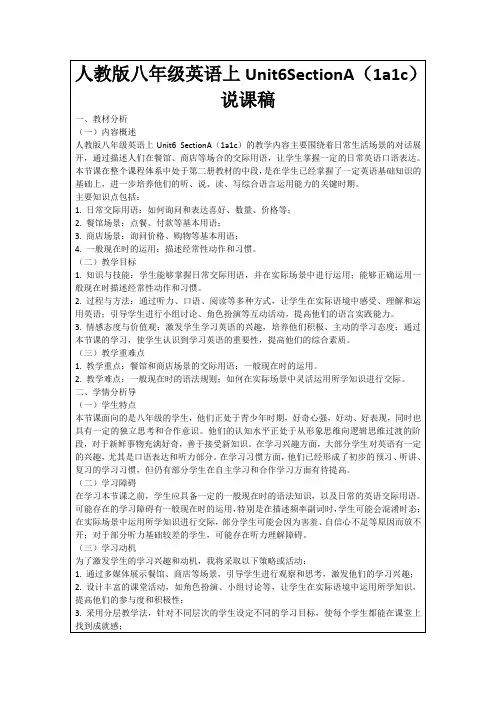
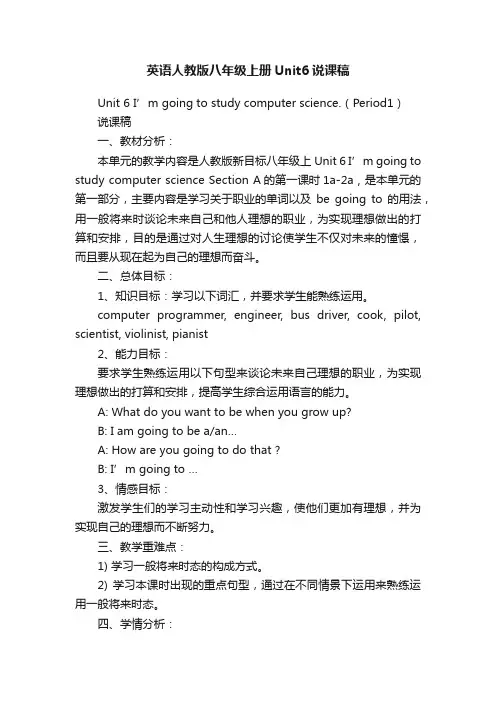
英语人教版八年级上册Unit6说课稿Unit 6 I’m going to study computer science.(Period1)说课稿一、教材分析:本单元的教学内容是人教版新目标八年级上Unit 6 I’m going to study computer science Section A的第一课时1a-2a , 是本单元的第一部分,主要内容是学习关于职业的单词以及be going to 的用法,用一般将来时谈论未来自己和他人理想的职业,为实现理想做出的打算和安排,目的是通过对人生理想的讨论使学生不仅对未来的憧憬,而且要从现在起为自己的理想而奋斗。
二、总体目标:1、知识目标:学习以下词汇,并要求学生能熟练运用。
computer programmer, engineer, bus driver, cook, pilot, scientist, violinist, pianist2、能力目标:要求学生熟练运用以下句型来谈论未来自己理想的职业,为实现理想做出的打算和安排,提高学生综合运用语言的能力。
A: What do you want to be when you grow up?B: I am going to be a/an…A: How are you going to do that ?B: I’m going to …3、情感目标:激发学生们的学习主动性和学习兴趣,使他们更加有理想,并为实现自己的理想而不断努力。
三、教学重难点:1) 学习一般将来时态的构成方式。
2) 学习本课时出现的重点句型,通过在不同情景下运用来熟练运用一般将来时态。
四、学情分析:本次教学面对的是普班学生,他们基础普遍薄弱,对学习没有很大信心。
所以本次教学中练习比较多,突出学生为主体,引导他们对未来生活的憧憬,培养学习英语的信心。
五、教学策略选择与设计基础英语阶段课程的目标是以学生语言技能、语言知识、情感态度、学习策略和文化意识的发展为基础,培养学生英语综合语言运用能力,让学生在教师的指导下,通过感知、体验、实践、参与和合作等方式,实现学习目标,感受成功。
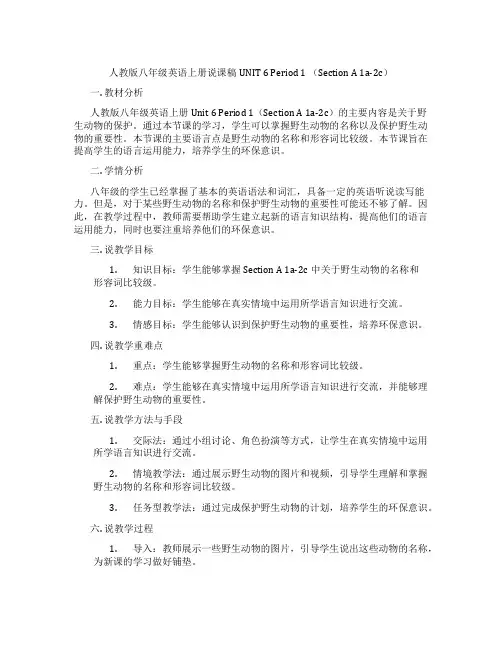
人教版八年级英语上册说课稿UNIT 6 Period 1 (Section A 1a-2c)一. 教材分析人教版八年级英语上册Unit 6 Period 1(Section A 1a-2c)的主要内容是关于野生动物的保护。
通过本节课的学习,学生可以掌握野生动物的名称以及保护野生动物的重要性。
本节课的主要语言点是野生动物的名称和形容词比较级。
本节课旨在提高学生的语言运用能力,培养学生的环保意识。
二. 学情分析八年级的学生已经掌握了基本的英语语法和词汇,具备一定的英语听说读写能力。
但是,对于某些野生动物的名称和保护野生动物的重要性可能还不够了解。
因此,在教学过程中,教师需要帮助学生建立起新的语言知识结构,提高他们的语言运用能力,同时也要注重培养他们的环保意识。
三. 说教学目标1.知识目标:学生能够掌握Section A 1a-2c中关于野生动物的名称和形容词比较级。
2.能力目标:学生能够在真实情境中运用所学语言知识进行交流。
3.情感目标:学生能够认识到保护野生动物的重要性,培养环保意识。
四. 说教学重难点1.重点:学生能够掌握野生动物的名称和形容词比较级。
2.难点:学生能够在真实情境中运用所学语言知识进行交流,并能够理解保护野生动物的重要性。
五. 说教学方法与手段1.交际法:通过小组讨论、角色扮演等方式,让学生在真实情境中运用所学语言知识进行交流。
2.情境教学法:通过展示野生动物的图片和视频,引导学生理解和掌握野生动物的名称和形容词比较级。
3.任务型教学法:通过完成保护野生动物的计划,培养学生的环保意识。
六. 说教学过程1.导入:教师展示一些野生动物的图片,引导学生说出这些动物的名称,为新课的学习做好铺垫。
2.新课呈现:教师通过展示野生动物的图片和视频,引导学生学习和掌握野生动物的名称和形容词比较级。
3.课堂练习:学生通过完成练习题,巩固所学知识。
4.小组讨论:学生分组讨论如何保护野生动物,并完成一个保护野生动物的计划。
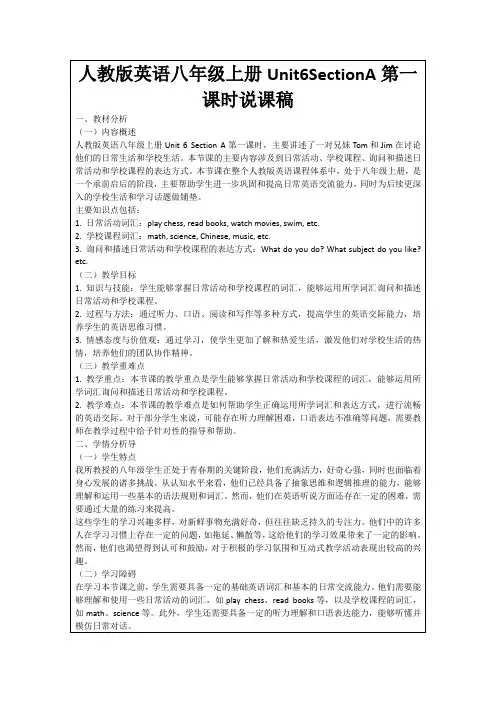
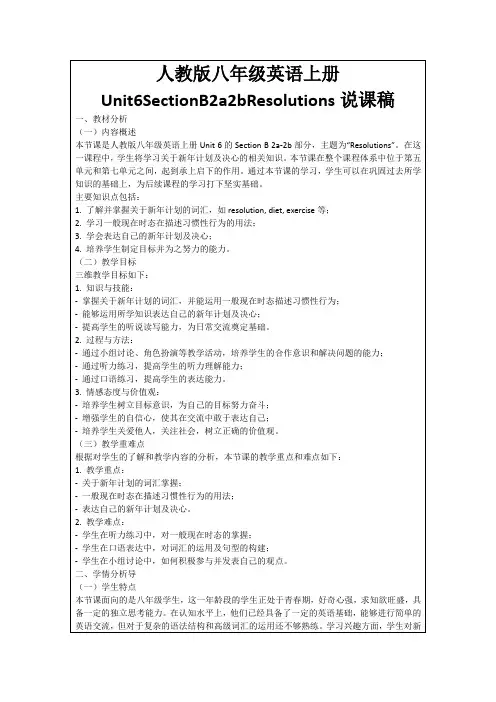

Unit 6I'm going to study computer science.Language Goal 【语言目标】Talk about future intentions:in this unit,students learn to talk about future intentions and express future with be going to;want to be;what,where,when,how questions.KnowledgeGoals 【知识目标】Key Wordscook,doctor,engineer,violinist,driver,pilot,pianist,scientist,college,education,medicine,university,London,send,team,foreign,question,meaning,discuss,promise,beginning,improve,physical,hobby,weekly,schoolwork,agree,own,personal,relationshipKey Phrasesgrow up,be sure about,make sure,write down,have to do with,take up,agree with,try one'sbest,have…in common,make promise,for thisreasonKey Sentences1.—What do you want to be when you grow up?—I want to be a basketball player.2.—How are you going to do that?—I'm going to practice basketball every day. Key GrammarLearn to express future with be going to,want tobe,what,where,when,how questions.Ability Goals【能力目标】Use the structure “be going to” to express your future intentions.Moral Goals 【情感目标】1. Talk about your golden dream about future freely.2.Work hard and you'll achieve your dream some day in the future.Teaching Time 【课时】Five periodsPeriod 1 Section A(1a-2d)Period 2 Section A(Grammar Focus-3c)Period 3 Section B(1a-1e)Period 4 Section B (2a-2e)Period 5 Section B (3a-Self Check)Section A 1a呈现了几种不同的职业,要求学生根据趣味性为其排序。
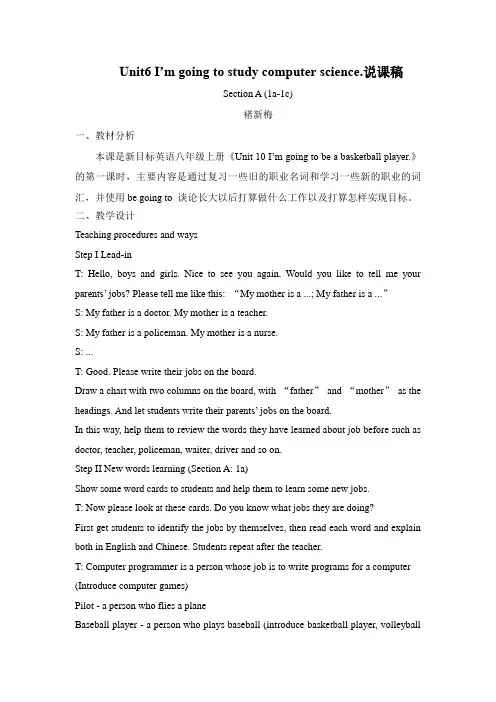
Unit6 I’m going to study computer science.说课稿Section A (1a-1c)褚新梅一、教材分析本课是新目标英语八年级上册《Unit 10 I’m going to be a basketball player.》的第一课时,主要内容是通过复习一些旧的职业名词和学习一些新的职业的词汇,并使用be going to 谈论长大以后打算做什么工作以及打算怎样实现目标。
二、教学设计Teaching procedures and waysStep I Lead-inT: Hello, boys and girls. Nice to see you again. Would you like to tell me your parents’ jobs? Please tell me like this: “My mother is a ...; My father is a ...”S: My father is a doctor. My mother is a teacher.S: My father is a policeman. My mother is a nurse.S: ...T: Good. Please write their jobs on the board.Draw a chart with two columns on the board, with “father”and “mother”as the headings. And let students write their parents’ jobs on the board.In this way, help them to review the words they have learned about job before such as doctor, teacher, policeman, waiter, driver and so on.Step II New words learning (Section A: 1a)Show some word cards to students and help them to learn some new jobs.T: Now please look at these cards. Do you know what jobs they are doing?First get students to identify the jobs by themselves, then read each word and explain both in English and Chinese. Students repeat after the teacher.T: Computer programmer is a person whose job is to write programs for a computer (Introduce computer games)Pilot - a person who flies a planeBaseball player - a person who plays baseball (introduce basketball player, volleyballplayer ...)Engineer - someone whose job is to design or build roads, bridges, machines etc Actor - a man who plays a role in a play or a film or television programs (introduce actress)Ask some students to read each new word to the class, correct their pronunciations. T: Do you think these jobs are interesting? (Students may have all kinds of responses.) Now rank them please. 1 is the most interesting and 6 is the least interesting.Check their answers and find out the most interesting job in the students’ eyes.T: Who made engineer number 1? Hands up! ...Step III Function presentationT: (Ask one of the students) Would you like to be a computer programmer in the future?S: Yes. I like to be a computer programmer.T: That is to say, “You are going to be a computer programmer in the future.”(On the board)Circle “are going to” on the board.T: Tod ay we’ll learn to talk about future intentions using “be going to”. Future intention means something you want to do or plan to do in the future. Clear?Ss: Yes.T: We learned to talk about future plans using “be +v-ing” structure in unit 3. Remember? Could you give me an example?S: I’m buying a new bike. (Write on the board and circle the “-ing”word)S: —Where are you going next week?—I’m going to my grandmother’s home next week.T: Very good. We can use “be+v-ing”to talk about future events. Today we’ll talk about future intentions using “be going to”structure. Look at this sentence:I’m going to be a computer programmer when I grow up. (On the board)Circle “when I grow up” and point out that it is not a question but means time.T: Please read after me.Students repeat the sentence after the teacher. Then let them practice making moresentences with the words in activity 1a, using the structure: I am going to be a ... Step IV Listening (Section A: 1b)Call attention to the items in activity 1b. Let students read the items before listening to the tape. Then tell them what they are supposed to do.T: Look at the example given. “computer programmer” is connected with “study computer science”. That is to say, if you are going to be a computer programmer, you should/need to study computer science. Clear?Then play the tape, students do the match work.Play the tape again and students check their answers.After listening, ask students to practice reading the phrases in activity 1b and explain what a professional basketball player is.Step V Oral practice (Section A: 1c)First get students to practice the conversation in 1c on page 59 in pairs.Call attention to the two questions:What are you going to be when you grow up?How are you going to do that?T: What-question asks about the jobs and how-question asks about the actions you will take. Is that clear? Now look at the conversation in the picture. Let’s read it. Boys play role A. Girls play role B. Together, OK?Then let them work in pairs and make more conversations about the other jobs.Get several pairs to demonstrate their conversations to the class.Step VI Summery and HomeworkT: Now let’s come back to the key words and sentences we have learned today. Pointing to the board, let boys read the key words first and ask girls if they have made some mistakes, and then let girls ask and boys answer using the sentences on the board.Call attention to the word order, pointing out we should say “what are you” not “what you are”, “how are you” not “how you are”.On the board:Homework:Have a conversation about your future job with your partner and write down your conversation on your exercise book. Please use what and how questions.三、课后反思对于本节课内容来说,重点就是职业词汇和两个句型,掌握一般将来时be going to +V (动词原形)。
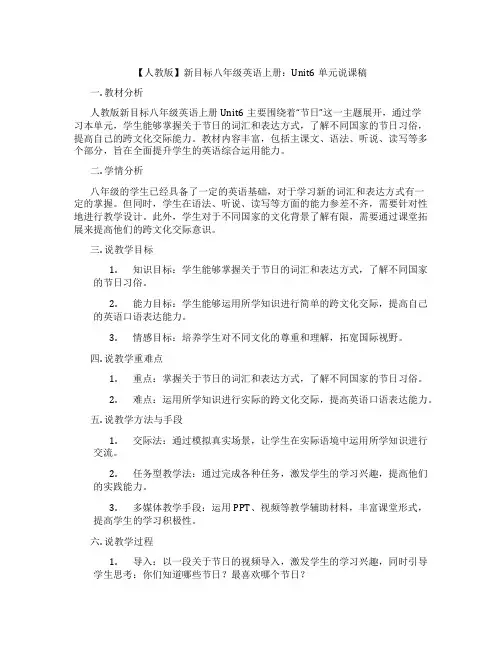
【人教版】新目标八年级英语上册:Unit6单元说课稿一. 教材分析人教版新目标八年级英语上册Unit6主要围绕着“节日”这一主题展开,通过学习本单元,学生能够掌握关于节日的词汇和表达方式,了解不同国家的节日习俗,提高自己的跨文化交际能力。
教材内容丰富,包括主课文、语法、听说、读写等多个部分,旨在全面提升学生的英语综合运用能力。
二. 学情分析八年级的学生已经具备了一定的英语基础,对于学习新的词汇和表达方式有一定的掌握。
但同时,学生在语法、听说、读写等方面的能力参差不齐,需要针对性地进行教学设计。
此外,学生对于不同国家的文化背景了解有限,需要通过课堂拓展来提高他们的跨文化交际意识。
三. 说教学目标1.知识目标:学生能够掌握关于节日的词汇和表达方式,了解不同国家的节日习俗。
2.能力目标:学生能够运用所学知识进行简单的跨文化交际,提高自己的英语口语表达能力。
3.情感目标:培养学生对不同文化的尊重和理解,拓宽国际视野。
四. 说教学重难点1.重点:掌握关于节日的词汇和表达方式,了解不同国家的节日习俗。
2.难点:运用所学知识进行实际的跨文化交际,提高英语口语表达能力。
五. 说教学方法与手段1.交际法:通过模拟真实场景,让学生在实际语境中运用所学知识进行交流。
2.任务型教学法:通过完成各种任务,激发学生的学习兴趣,提高他们的实践能力。
3.多媒体教学手段:运用PPT、视频等教学辅助材料,丰富课堂形式,提高学生的学习积极性。
六. 说教学过程1.导入:以一段关于节日的视频导入,激发学生的学习兴趣,同时引导学生思考:你们知道哪些节日?最喜欢哪个节日?2.新课呈现:通过PPT展示本节课的主要内容,包括节日词汇和表达方式,不同国家的节日习俗等。
3.课堂实践:模拟真实场景,让学生分组进行角色扮演,运用所学知识进行跨文化交际。
4.语法讲解:针对本节课的语法点,进行详细的讲解和示例,让学生在理解的基础上进行运用。
5.听力训练:播放一段关于节日的听力材料,学生听后进行问答,检查学生对听力材料的理解程度。
说课稿unit6 I’m more outgoing than my sister.一、Analysis of the Teaching Material.(教材分析)1.Status and Function(教材的地位和作用)The topic of Unit6 is about personal traits. This kind of topic is closely related to students’ daily life , so all the activities in this unit are helpful to raise learning interest of students. This can make students learning English happily.(这个单元主要学习形容词的比较级,谈论有关个人的话题,个人的特征。
这种话题与学生的日常生活有着密切的联系,所以所有的话题对于提高学生学习英语的兴趣有很大的帮助,这样就能使学生在轻松愉快中学习英语,享受英语。
2.Teaching Aims and Demands(.教学目标.)依据新课标“在重视英语知识教育的同时,更为重视英语能力培养和情感态度、价值观教育,同时要发展学生探究性学习的能力”这一理论,我制定如下教学目标:1)Knowledge Objects(知识目标):Key vocabulary(本单元重要词汇)the rules of the comparative degree of adjectives (形容词比较级的变化规则)2)Ability Objects(能力目标)Make the students talk a bout their own topic in English and try to use the comparative degree of adjectives. It will help them improve listening skill and communicative competence.(指导学生在自主探究和任务型教学模式中,让学生学会用英语与他人谈论人的个性特征和形容词的比较的话题,以及进一步提高听力能力和英语语言表达能力).3)“情感、态度、价值观”目标:(1)通过和别人作比较了解他人的长处和自己的短处,教育学生“行为漂亮才是漂亮”Handsome is that handsome does.(2)教育学生关注自己和身边的人。
人教版八年级英语上册说课稿UNIT 6 Period 5 (Section B 3a-Self Check)一. 教材分析人教版八年级英语上册Unit 6 Period 5(Section B 3a-Self Check)的主要内容是关于节日和文化活动的。
通过本节课的学习,学生能够掌握关于节日和文化的相关词汇和表达方式,提高听说读写的能力,并了解不同国家和地区的文化差异。
二. 学情分析八年级的学生已经具备了一定的英语基础,能够理解和运用一些基本的英语词汇和句型。
但是,对于一些特定的文化背景和表达方式可能还不够了解,需要通过本节课的学习来提高。
三. 说教学目标1.知识目标:学生能够掌握关于节日和文化的相关词汇和表达方式。
2.能力目标:学生能够提高听说读写的能力,并能够用英语简单介绍自己喜欢的节日或文化活动。
3.情感目标:学生能够了解不同国家和地区的文化差异,培养跨文化交际的意识。
四. 说教学重难点1.重点:学生能够掌握关于节日和文化的相关词汇和表达方式。
2.难点:学生能够用英语流畅地介绍自己喜欢的节日或文化活动,并能够正确运用语法和词汇。
五. 说教学方法与手段1.任务型教学法:通过设定各种任务,激发学生的学习兴趣,提高学生的参与度。
2.合作学习法:通过小组讨论和合作,培养学生的团队协作能力和沟通能力。
3.多媒体辅助教学:利用多媒体课件和视频等资源,丰富教学内容,提高学生的学习兴趣。
六. 说教学过程1.导入:通过展示一些节日的图片,引导学生谈论自己喜欢的节日,激发学生的学习兴趣。
2.呈现:通过课件和视频,展示不同国家和地区的节日和文化活动,帮助学生了解和感受不同的文化氛围。
3.任务型活动:学生分组,每组选择一个节日或文化活动,用英语进行介绍,培养学生的口头表达能力。
4.阅读理解:学生阅读Section B 3a的短文,回答相关问题,提高学生的阅读理解能力。
5.语法练习:通过一些语法练习,帮助学生巩固和运用所学知识。
初二英语上册unit6说课稿Unit 6 说课稿尊敬的各位老师,大家好。
今天,我将就初二英语上册的第六单元进行说课。
本单元的主题是“购物”,旨在通过与购物相关的语言点和活动,提高学生的英语交际能力。
一、教学目标1. 知识目标:学生能够掌握购物相关的词汇,如“size”, “color”, “price”, “discount”等,并能够使用这些词汇进行基本的购物对话。
2. 能力目标:通过模拟购物场景,学生能够运用所学词汇和句型进行实际的购物交流。
3. 情感目标:培养学生的购物礼仪和消费观念,理解并实践公平交易和诚信购物。
二、教学重点1. 购物相关的词汇和表达方式。
2. 如何询问物品的价格、颜色、尺寸等信息。
3. 表达购买意愿和拒绝购买的礼貌用语。
三、教学难点1. 学生能够灵活运用购物相关的句型进行交流。
2. 理解并运用购物时的礼貌用语和交际技巧。
四、教学方法1. 情景教学法:通过模拟购物场景,让学生在实际情境中学习和使用语言。
2. 合作学习法:鼓励学生分组合作,通过角色扮演等形式,共同完成购物任务。
3. 任务型教学法:设置具体的购物任务,让学生在完成任务的过程中学习和运用语言。
五、教学过程1. 导入(Lead-in):- 通过展示一些购物图片或视频,激发学生对购物话题的兴趣。
- 简单讨论学生平时的购物经历,引导学生思考购物时可能用到的英语表达。
2. 呈现(Presentation):- 教授购物相关的词汇和句型,如“Can I help you?”, “What size/color do you want?”, “How much is it?”等。
- 通过图片或实物,帮助学生直观理解词汇。
3. 练习(Practice):- 学生两人一组,进行角色扮演练习,模拟购物对话。
- 教师提供一些购物场景,让学生用所学句型进行对话。
4. 应用(Application):- 组织一个模拟购物活动,学生需要使用英语完成购物任务。
教案人教版八年级上册unit6英语教案(共5篇)第一篇:教案人教版八年级上册unit6英语教案Unit6I’m going to study computer science Section A 1a-1c一、教学准备:多媒体课件二、Teaching aims:1、Knowledge aim:要求学生掌握关于职业的名词:computer programmer , engineer, bus driver, basketball player, cook, teacher, pilot, scientist, doctor, violinist, pianist, Actor.., Sentence patterns:what do you want to be when you grow up?I want to be a/an...How are you going to do that?I’m going to...语法:be going to...表示一般将来时2、Ability aims:能听懂有关人生理想的词汇及表达;能听懂有关未来计划的表达;能进行有关人生的谈话;能进行有关将来计划的讨论;培养学生应用英语谈论将来计划;提高学生听、说、读、写等能力。
3、Emotion aims:通过对人生理想的讨论,让学生从小就树立自己的人生理想,并且现在就下定决心,为理想而努力奋斗,使他们成为有理想,有抱负,有动力,健康成长的新一代青少年。
三、Teaching keys and difficulties:1、重点词汇:computer programmer , engineer, bus driver, basketball player, cook, teacher, pilot, scientist, doctor, violinist, pianist, Actor...2、重点句型:what do you want to be when you grow up?I want to be a/an...How are you going to do that?I’m going to...3、难点:语法:一般将来时be going to 中be的具体形式和后面接动词原形的用法学生容易混淆,学生根据自己喜欢的职业,运用所学知识谈论自己打算怎样做来实现目标则既是难点,有时能力训练点。
《新目标英语》八年级上册第六单元教学案例
Unit 6 I’m more outgoing than my sister.
(Section A)
[教材分析]
教学内容为“Go for it ”新目标英语八年级上册第六单元Section A (1a-3c)。
学习内容主要体现在以下3点:
1、学习有关人物特点的单词:tall, fat, thin, short, heavy, calm,
wild, long hair, short hair, outgoing, quiet, funny, serious, smart, athletic, beautiful, ect.
2、学习人物比较的重要句型:
(1)Pedro is funnier than Paul.
(2)Tina is taller than Tara.
(3)Tom is more athletic than Sam.
3、掌握语法点:the comparative and superlative degrees of
adjectives (形容词的比较级和最高级)
[学生分析]
1、利用多媒体课件上英语课,学生视听感受明显,表现出极大兴趣,
在欣赏和享受中学习,学习效果很明显。
2、学生以前已经学过有关人物特点的单词,但不会将其变形,用于人
物或事物的比较中。
通过对本课的学习可以巩固所学知识,掌握用
正确的语言结构表达人物特点和人物比较。
[教学目标]
本课以素质教育为目的,结合教材重点、难点及英语学科特点,利用多媒体辅助教学,从视、听、说等方面使学生得到锻炼,在愉快、轻松的氛围中温故而知新,达到初步运用英语交际的能力。
1、谈论学生感兴趣的话题以及播放学生熟悉的人物图片,指导学生学
习有关人物特点的单词、人物比较的表达及语法知识点“形容词的
比较级和最高级”。
2、通过学习本课,增强师生、生生间的相互了解和沟通。
3、培养学生的口头表达能力、理解能力和提高学生听力水平。
[教学设计]
本节课的教学内容一共有五个部分:lead-in; words study; listening and speaking; comparison degree learning; homework.
Step 1 Lead-in(10minutes)
1.把全班学生分为四个小组,看哪个小组能说出最多的关于人物外貌或性格的形容词。
teacher: Which group can tell me the adjective words(形容词)about appearance (外貌) and personalities (性格) as many as possible
2.展示一些名人或有趣的相片,并和学生谈论他们的人物特点。
[1、复习已学内容,自然延伸到新课学习,起到承上启下的作用。
2、开展竞赛活动,既可调动课堂气氛,又可提高学生求知欲望,一举两得。
]Step 2 words study(5minutes)
在学生已掌握部分人物特点形容词的情况下,增加新的单词,扩充学生词汇量。
Step 3 Listening and speaking(15minutes)
I. Listening
1、Listen to the tape and number the pictures in 1b.
2、Listen to the tape and complete the chat in 2a. Listen again
and fill in chat in 2b.
3、Check the answers.
[听力训练既是对知识的巩固,也为下一步的任务输出提供了输入材料。
]
II. speaking
One student describe one of classmates’characteristic or appearance and others try to guess who he/she is
[利用学生之间的熟悉程度让学生更容易表达人物特点;通过口头表达,纠正学生发音以及检验学生对比较级的掌握程度;通过生生之间的互动,增进学生之间的感情]
Step 4 comparison degree learning(15minutes)
1展示相互比较的图片,让学生归纳规则单音节词及少数双音节词、多音节词比较级的构成形式。
在课堂上让学生多动脑思考,养成其独立思考解决问题的习惯。
2观看图片,学生口头回答关于形容词比较级的练习【图文并茂,激发学生的学习兴趣,并且有利于加深学生课堂记忆】
Step 5Homework
1、Do Workbook Exx.1-3.
2、Preview Section B.
[教学材料备份]
此课堂是主要建立在利用多媒体教学设备进行教学的,作为教师不能是依靠多媒体,而应该是借助多媒体设备进行教学。
所以教师应该考虑到设备可用性问题,在课前将教学材料备份。
如:准备纸质相片以备ppt不能正常播放。